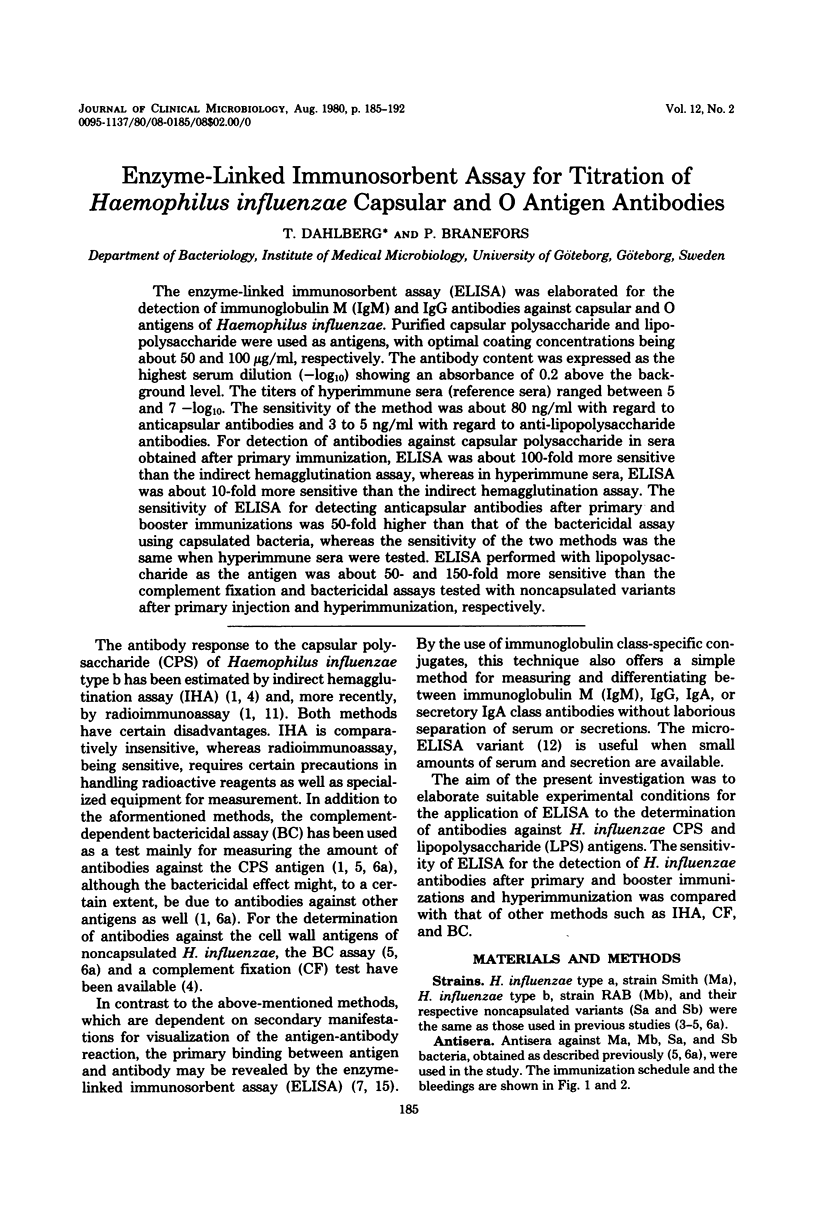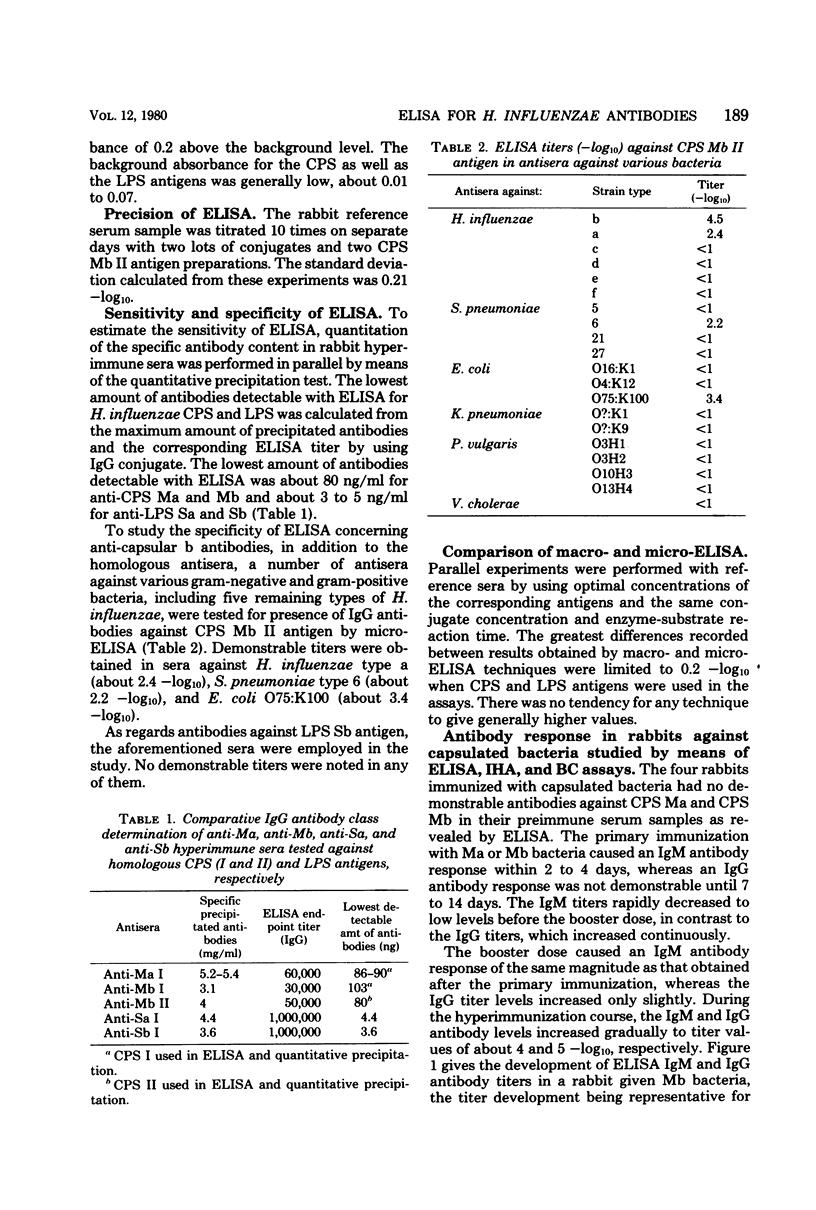Abstract
The enzyme-linked immunosorbent assay (ELISA) was elaborated for the detection of immunoglobulin M (IgM) and IgG antibodies against capsular and O antigens of Haemophilus influenzae. Purified capsular polysaccharide and lipopolysaccharide were used as antigens, with optimal coating concentrations being about 50 and 100 micrograms/ml, respectively. The antibody content was expressed as the highest serum dilution (-log10) showing an absorbance of 0.2 above the background level. The titers of hyperimmune sera (reference sera) ranged between 5 and 7 -log10. The sensitivity of the method was about 80 ng/ml with regard to anticapsular antibodies and 3 to 5 ng/ml with regard to anti-lipopolysaccharide antibodies. For detection of antibodies against capsular polysaccharide in sera obtained after primary immunization, ELISA was about 100-fold more sensitive than the indirect hemagglutination assay, whereas in hyperimmune sera, ELISA was about 10-fold more sensitive than the indirect hemagglutination assay. The sensitivity of ELISA for detecting anticapsular antibodies after primary and booster immunizations was 50-fold higher than that of the bactericidal assay using capsulated bacteria, whereas the sensitivity of the two methods was the same when hyperimmune sera were tested. ELISA performed with lipopolysaccharide as the antigen was about 50- and 150-fold more sensitive than the complement fixation and bactericidal assays tested with noncapsulated variants after primary injection and hyperimmunization, respectively.
Full text
PDF







Selected References
These references are in PubMed. This may not be the complete list of references from this article.
- Bergholtz B. O., Thorsby E. HLA-D restriction of the macrophage-dependent response of immune human T lymphocytes to PPD in vitro: inhibition by anti-HLA-DR antisera. Scand J Immunol. 1978;8(1):63–73. doi: 10.1111/j.1365-3083.1978.tb00496.x. [DOI] [PubMed] [Google Scholar]
- Branefors-Helander P. Antigen-free medium for cultivation of Haemophilus influenzae, AFH-medium. Acta Pathol Microbiol Scand B Microbiol Immunol. 1972;80(2):211–220. doi: 10.1111/j.1699-0463.1972.tb00151.x. [DOI] [PubMed] [Google Scholar]
- Branefors-Helander P. Serological studies of Haemophilus influenzae. I. Extracellular antigens of capsulated strains, types a to f, and two non-capsulated variants. Int Arch Allergy Appl Immunol. 1972;43(4):533–547. [PubMed] [Google Scholar]
- Branefors-Helander P. Serological studies of Haemophilus influenzae. IV. The antibody response in rabbits against capsular and O antigens of H. influenzae. Int Arch Allergy Appl Immunol. 1973;45(5):657–674. [PubMed] [Google Scholar]
- Branefors P., Dahlberg T. Serum bactericidal effect on capsulated and non-capsulated Haemophilus influenzae. Acta Pathol Microbiol Scand C. 1980 Feb;88(1):47–56. doi: 10.1111/j.1699-0463.1980.tb00071.x. [DOI] [PubMed] [Google Scholar]
- Carlsson H. E., Lindberg A. A., Hammarström S. Titration of antibodies to salmonella O antigens by enzyme-linked immunosorbent assay. Infect Immun. 1972 Nov;6(5):703–708. doi: 10.1128/iai.6.5.703-708.1972. [DOI] [PMC free article] [PubMed] [Google Scholar]
- Dahlberg T., Branefors P. Characterization of the bactericidal antibody response against Haemophilus influenzae. Acta Pathol Microbiol Scand C. 1980 Jun;88(3):115–120. doi: 10.1111/j.1699-0463.1980.tb00082.x. [DOI] [PubMed] [Google Scholar]
- Engvall E., Perlmann P. Enzyme-linked immunosorbent assay, Elisa. 3. Quantitation of specific antibodies by enzyme-labeled anti-immunoglobulin in antigen-coated tubes. J Immunol. 1972 Jul;109(1):129–135. [PubMed] [Google Scholar]
- Holmgren J., Svennerholm A. M. Enzyme-linked immunosorbent assays for cholera serology. Infect Immun. 1973 May;7(5):759–763. doi: 10.1128/iai.7.5.759-763.1973. [DOI] [PMC free article] [PubMed] [Google Scholar]
- LOWRY O. H., ROSEBROUGH N. J., FARR A. L., RANDALL R. J. Protein measurement with the Folin phenol reagent. J Biol Chem. 1951 Nov;193(1):265–275. [PubMed] [Google Scholar]
- Norden C. W., Michaels R. Immunologic response in patients with epiglottitis caused by Haemophilus influenzae type b. J Infect Dis. 1973 Dec;128(6):777–780. doi: 10.1093/infdis/128.6.777. [DOI] [PubMed] [Google Scholar]
- Schneerson R., Bradshaw M., Whisnant J. K., Myerowitz R. L., Parke J. C., Jr, Robbins J. B. An Escherichia coli antigen cross-reactive with the capsular polysaccharide of Haemophilus influenzae type b: occurrence among known serotypes, and immunochemical and biologic properties of E. coli antisera toward H. influenzae type b. J Immunol. 1972 Jun;108(6):1551–1562. [PubMed] [Google Scholar]
- TUNEVALL G. Studies on haemophilus influenzae type characteristics. Acta Pathol Microbiol Scand. 1952;30(2):203–212. doi: 10.1111/j.1699-0463.1952.tb00175.x. [DOI] [PubMed] [Google Scholar]
- Voller A., Bidwell D. E., Bartlett A. Enzyme immunoassays in diagnostic medicine. Theory and practice. Bull World Health Organ. 1976;53(1):55–65. [PMC free article] [PubMed] [Google Scholar]


